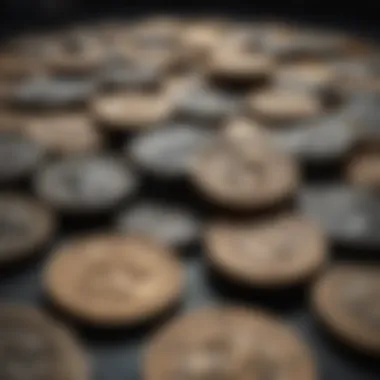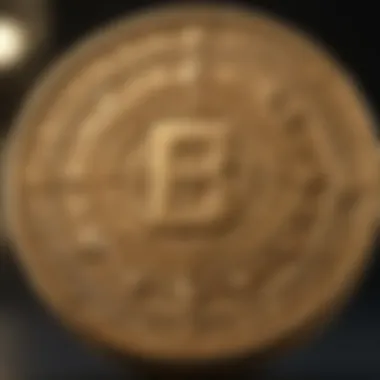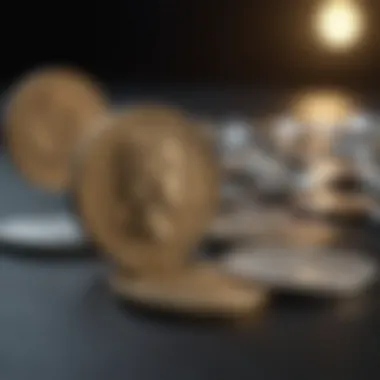The Ultimate Guide to Collectable Coins: Value & Trends


Investment Terminology
Understanding the vocabulary of collectable coins is vital for both new and seasoned collectors. This section will clarify key terms and common acronyms that are critical in navigating the collector's market.
Key Terms and Definitions
- Numismatics: The study or collection of currency, including coins, tokens, paper money, and related objects. Understanding numismatics helps in grasping the historical context behind collectable coins.
- Rarity: The scarcity of a coin. This can significantly influence its value. A limited mintage can often equate to a higher demand.
- Condition: This refers to how well a coin is preserved. The grading system assesses condition based on factors like wear, damage, and overall aesthetics. Coins can be classified from Poor (G) to Perfect Uncirculated (MS70).
- Authentication: The process of verifying the originality of a coin. This is crucial to avoid counterfeits and ensure the coin's value.
Common Acronyms in Finance
- PCGS: Professional Coin Grading Service, a well-known coin grading and authentication service.
- NGC: Numismatic Guaranty Corporation, another reputable grading service used widely by collectors.
- MS: Mint State, a grading term indicating that a coin is uncirculated and shows no significant wear.
Expert Insights
Gaining perspectives from seasoned professionals can greatly enhance your collecting experience. Here, we explore investment strategies and tips that can optimize your approach to collectable coins.
Investment Strategies Overview
Investing in collectable coins requires a strategic mindset. First, consider researching specific areas of interest. Whether it's ancient coins, modern bullion, or rare mint issues, understanding what drives the market in each category is crucial. Second, diversification is important. Investing in multiple types of coins can help mitigate risks associated with sudden market shifts.
Tips from Financial Advisors
- Start with Education: Familiarize yourself with numismatic resources, forums, and literature. Knowledge is a powerful tool in making informed decisions.
- Set a Budget: It is easy to get carried away in auctions or marketplaces. Having a defined budget helps in maintaining financial discipline.
- Network within the Community: Engage with other collectors. Connections can provide insights into market trends and offer potential buying options that are not widely advertised.
"Collecting coins is not just an investment; it is a journey through history. Each piece tells a story that deserves to be heard."
– Financial Advisor Insight
Through understanding these terminologies and incorporating expert strategies, both novice and experienced investors can enhance their approach to collecting coins. This foundation will significantly help when we later discuss valuation criteria and market dynamics.
Foreword to Collectable Coins
Collectable coins represent a unique intersection of history, art, and investment. They resonate not only with serious investors but also with those drawn to the stories behind each piece. Understanding the landscape of collectable coins can enhance not only your investment portfolio but also enrich your appreciation for numismatics as a whole. This guide aims to provide a detailed exploration of collectable coins, offering insights that cater to both novice and seasoned collectors.
Definition and Scope
Collectable coins, by definition, are coins valued for their rarity, historical significance, or aesthetic appeal rather than their face value. These coins can vary widely in terms of age, material, and cultural background. They encompass anything from ancient Greek drachmas to modern U.S. silver eagles. As a collector, understanding the scope of collectable coins is crucial. It is essential to identify what interests you. This can range from specific eras, such as Roman coins, to thematic collections, such as state quarters or historical commemoratives.
The range of collectable coins also extends to various materials, including gold, silver, and even base metals. This diversity allows collectors to explore different aspects of numismatics while establishing focused collections aligned with personal passions.
Brief History of Coin Collecting
Coin collecting dates back many centuries. It is widely believed that the practice began in ancient Rome, where wealthy citizens would collect significant coins as symbols of power and wealth. However, the modern organized collecting movement took shape during the Renaissance when educated individuals began to accumulate coins as part of their broader interest in art, culture, and history.
During the 19th century, particularly in the United States, coin collecting gained immense popularity. As coins of various types and eras became available, public interest surged. The establishment of professional organizations and publications helped to formalize the field, offering collectors resources to deepen their understanding.
Today, the Internet has transformed coin collecting. It allows access to vast amounts of information and marketplaces, enabling people to connect over shared interests. Online auctions and forums have made this hobby more accessible, fostering a new generation of collectors who can learn and grow from the community.
"Coin collecting is a fascinating hobby that combines history, art, and investment".
Types of Collectable Coins
Understanding the different types of collectable coins is essential for anyone interested in numismatics. Each category carries its unique appeal, history, and investment potential. Recognizing these nuances helps both new and seasoned collectors make informed decisions in their buying and selling activities. This section examines four primary types of collectable coins: Ancient Coins, Modern Coins, Commemorative Coins, and Bullion Coins.
Ancient Coins
Ancient coins hold significant historical value. They often date back hundreds or even thousands of years. Collectors are typically drawn to them for their artistry, rarity, and stories they tell about past civilizations. For example, coins from the Roman Empire or Greek city-states often feature intricate designs and inscriptions that provide insight into their cultural and political contexts.
Ancient coins can vary widely in terms of condition and rarity, which greatly influences their market value. Many collectors seek coins with a high level of preservation, while others might embrace well-worn specimens that reveal their history. The challenge here is often determining authenticity, as forgeries are not uncommon in this market.
"The allure of ancient coins lies in their stories, offering a tangible link to human history."
Modern Coins
Modern coins encompass those minted from the 19th century to the present day. This category includes everyday currency, commemorative editions, and limited runs produced for collectors. The appeal of modern coins often lies in their potential for appreciation, especially for those coins that are produced in limited quantities or feature unique designs.
For collectors, modern coins are more accessible due to their availability at local banks or coin shops. They often capture popular culture and societal events, making them relevant to contemporary collectors. However, it is essential to focus on quality and condition because these factors directly impact worth.
Commemorative Coins
Commemorative coins are often issued to honor a specific event, person, or milestone. Countries may release these coins to mark anniversaries, national celebrations, or important historical figures. Their design typically reflects the theme of commemoration, making them visually appealing to collectors.
These coins may have limited mintage, enhancing their desirability. Collectors find value in both the coin's artistic merit and the significance of its subject matter. As such, commemorative coins serve not only as collectible items but also as historical artifacts that embody cultural narratives.
Bullion Coins
Bullion coins are primarily valued for their precious metal content rather than their numismatic significance. Commonly made from gold, silver, or platinum, these coins are often minted in standard weights and purities. The primary motivation for purchasing bullion coins is investment, as they can serve as a hedge against inflation and currency fluctuations.
While the market for bullion coins can be less volatile than other types of collectable coins, their price typically tracks the market value of the underlying metal. This makes them both a collector's item and a viable investment option. Examples include the American Eagle gold coins and the Canadian Maple Leaf.
In summary, the types of collectable coins provide valuable insights into the diverse interests of collectors. Each category has its unique characteristics that appeal to different motivations, whether they be aesthetic, historical, or financial. Understanding these differences helps collectors navigate the vast numismatic landscape effectively.


The Market for Collectable Coins
The market for collectable coins is a pivotal aspect in understanding the broader context of coin collecting. Knowing how this marketplace operates allows both new and seasoned collectors to navigate their investments more effectively. Factors like market demand, pricing trends, and overall economic conditions come into play. This section illuminates these dynamics, providing insight into why this market can be both lucrative and complex.
Market Dynamics
Market dynamics in the realm of collectable coins can shift rapidly, influenced by a variety of elements. Economic shifts, changes in collector preferences, and global events are examples of drivers that affect pricing and availability.
The coin market is heavily influenced by several factors such as:
- Historical Events: Coins minted during significant periods often hold greater value.
- Media Exposure: High-profile auctions or sales can spark interest and drive demand for specific coins.
- Economic Conditions: Inflation or monetary policy changes can impact the price of precious metals and, consequently, the value of collectable coins.
It's critical for collectors to stay informed about these factors to catch opportunities as they arise. For instance, coins linked to noteworthy historical moments may see a price rise when anniversaries are celebrated. Thus, recognizing patterns in the market can aid collectors in making informed decisions.
Understanding Demand and Supply
The principles of demand and supply are central to the market for collectable coins. Factors affecting these principles directly influence coin values.
- Demand: Factors that increase demand include heightened interest in numismatics, trends towards tangible investments, and a growing population of collectors.
- Supply: Availability can fluctuate due to several factors such as coin rarity, the volume of coins being minted, and collectors deciding to sell their items.
Both demand and supply are influenced by several nuances:
- Collector Trends: Changing tastes among collectors can affect demand for different types of coins. Vintage coins may fall out of favor while modern pieces gain traction.
- Market Events: Auctions, conventions, and online platforms can create bursts of demand for particular coins.
Understanding the balance of demand and supply helps in predicting market shifts. Analysis of historical data can inform future purchases and sales, making it crucial for a successful collection.
"Collectors often miss the subtleties of market dynamics, leading to uninformed purchases or sales. Awareness here is essential to protect your investment."
The interplay of these factors makes the market lively and challenging. Collectors who actively engage with the market and understand its nuances stand a better chance of thriving in a complex landscape.
Valuation Criteria for Collectable Coins
When entering the realm of collectable coins, understanding valuation criteria is crucial. It helps collectors determine the worth of their coins, whether they seek to buy or sell. These criteria influence decision-making and provide insights into market trends. A collector's ability to assess value can significantly impact their collecting journey and investment potential.
Condition and Grading Systems
The condition of a coin is perhaps the most significant factor in its valuation. Coins are graded based on their physical state, which ranges from well-worn to mint condition. This grading system is integral in the collecting community. A common grading scale is from one to seventy, known as the Sheldon Scale.
- Poor (P-1): Nearly unrecognizable with heavy wear.
- Good (G-4): Some detail remains, but much is worn away.
- Uncirculated (MS-60): Show no signs of wear, but may exhibit some blemishes.
Understanding this grading system allows collectors to communicate effectively and make informed purchasing decisions. It also enhances the authenticity of the trade. Collectors should seek coins with a higher grade to ensure future appreciation in value.
Rarity and Demand
Rarity plays a significant role in determining a coin's worth. Coins that are limited in number tend to command higher prices. Rarity can result from many factors, such as mintage numbers, market demand, or historical events that led to fewer coins being produced.
Demand is equally vital and often fluctuates based on trends among collectors and investors. Factors influencing demand include:
- Popularity of collecting: Certain coins gain popularity through media and community interest.
- Cultural significance: Coins related to notable events or figures typically have higher demand.
The intersection of rarity and demand determines a coin's market value and is essential for collectors to analyze.
Historical Significance
The historical context surrounding a coin can greatly enhance its value. Coins that hold significant historical events—like a year with important political changes or commemorative issues—tend to attract collectors' attention. Understanding a coin's background provides deeper insights into its value.
Additionally, such coins often tell a story which can add to their allure:
- Commemorative coins: Mark specific events, celebrations, or milestones in culture or history.
- Ancient coins: Offer insights into ancient civilizations and their economies.
Collectors should consider both the history and the story behind each coin. This not only adds to the enjoyment of collecting but also provides a solid basis for valuation.
Authentication and Certification
Authentication and certification stand as cornerstones in the realm of collectable coins. Establishing the validity of a coin is paramount for collectors, investors, and traders alike. Given the vast number of counterfeit coins that exist today, understanding the process of authentication ensures that collectors invest in genuine items, preserving their investment's value over time.
One of the key benefits of authentication is the peace of mind it provides. Collectors can be confident that the coins in their collection are not only genuine but also that they meet specific criteria that enhance their value. If a coin lacks authentication, its market value can drop significantly. Collectors must take care not to overlook this aspect as they build their collections.
Importance of Authenticity
Authenticity plays a critical role in the perception and value of collectable coins. A real coin can command higher prices, especially if it is rare or part of a significant historical event. Conversely, if a coin is deemed a counterfeit or lacks proper documentation, collectors may find themselves unable to sell or potentially losing their initial investment.
The risks associated with unauthenticated coins can include:
- Financial Loss: Investing in a counterfeit coin can lead to substantial financial setbacks.
- Legal Issues: In some jurisdictions, selling counterfeit coins may lead to legal ramifications.
- Market Reputation: Collectors risk their standing within the community if they are known to deal in forgeries.
Establishing authenticity involves various methods, including physical examination, research into issuance, and expert assessments. Overall, the value attached to a coin is heavily reliant on its authenticity, creating an essential need for verification in the coin collecting world.
Professional Grading Services
Professional grading services have emerged as pivotal in the authentication process of collectable coins. These services evaluate coins based on a standardized system, providing an objective grading scale that establishes the condition and marketability of coins. Some of the well-known organizations include the Professional Coin Grading Service (PCGS) and the Numismatic Guaranty Corporation (NGC).


When using a professional grading service, collectors gain numerous advantages:
- Standardization: Grading systems are consistent across the industry, ensuring every coin is judged under the same criteria.
- Market Value: Coins that have been graded and certified from recognized services often fetch higher prices at auctions.
- Resale Assurance: Investors can obtain a better price for coins that offer validated condition and authenticity, attracting potential buyers who value certified collectibles.
However, it is essential for collectors to select reputable grading companies. Doing thorough research and asking for recommendations within collecting communities can help ensure that coins are sent to a trusted entity.
Starting a Collectable Coin Collection
Starting a collectable coin collection is a venture that requires careful thought and planning. It is not merely an act of acquiring coins; it involves setting a path that aligns with personal interests and investment goals. The significance of having a clear direction cannot be overstated. A defined purpose helps prioritize purchases, making the collection more cohesive and enjoyable. Consideration of what type of coins to collect, such as ancient, modern, or commemorative, can guide early decisions. By focusing on themes or specific eras, collectors can add depth and personal meaning to their collecting journey.
Setting Goals for Your Collection
Establishing goals is fundamental in shaping a successful coin collection. Collectors should ask themselves various questions. Do they wish to build a valuable investment portfolio or simply enjoy the history behind each piece? Setting both short-term and long-term goals will assist in tracking progress and evaluating success.
- Define Your Purpose: This might include objectives like historical exploration, investment returns, or completing a specific set.
- Budgeting: Determine how much you can afford to spend. This helps in managing finances and setting realistic expectations.
- Types of Coins: Choose a category that interests you. Areas might include rare coins, world coins, or even thematic collections.
- Time Frame: Develop a timeline for reaching your goals, whether it's completing a certain collection by a specific year or gradually acquiring key pieces.
Having a structured plan makes it easier to stay focused. Each decision on what to buy will then align with the established goals, facilitating a more fulfilling experience.
Resources for New Collectors
For those beginning their collecting journey, various resources can provide invaluable support. A combination of educational materials and community engagement can enhance understanding and skills. Here are several resources to consider:
- Books and Magazines: Publications like "The American Numismatic Association's Guide to Coin Collecting" offer foundational insights.
- Online Forums: Engaging with communities on websites like reddit.com can connect you with seasoned collectors who can provide guidance and share experiences.
- Social Media Groups: Joining groups on platforms such as facebook.com can expose you to current trends and deeper discussions about the hobby.
- Local Coin Shows: Attend coin shows to see coins in person, interact with dealers, and gain knowledge about market practices.
These resources create a supportive environment. They equip you with the necessary tools to navigate the complexities of coin collecting.
Buying Collectable Coins
Buying collectable coins is a pivotal aspect of coin collecting that can significantly influence the trajectory of a collector’s journey. It involves not only purchasing coins but also understanding the market and being educated about the coins themselves. When beginning, collectors must focus on where to buy and how to make informed decisions. This knowledge can prevent costly mistakes and enhance the value of their collections over time.
Where to Buy
Finding the right sources for purchasing collectable coins is essential. Collectors can choose from multiple venues, each offering unique advantages and potential pitfalls. Here are some common options:
- Coin Shows: These events provide opportunities to browse a wide variety of coins from different dealers. It’s also a chance to negotiate prices and build networks in the coin community.
- Coin Dealers: Established dealers often have valuable insights and a reliable stock. It can be beneficial to develop relationships with trusted dealers who can provide guidance on high-value pieces.
- Online Marketplaces: Websites like eBay and Etsy can offer a vast selection of coins. However, it’s crucial to conduct thorough research on sellers and read reviews to ascertain credibility.
- Auctions: Participating in auction houses allows collectors to bid on rare coins. This path may yield high rewards, but it also requires a solid understanding of auction dynamics and possibly higher costs.
- Local Coin Shops: These shops can be excellent places for finding specific coins and getting personalized service. Local shops might also provide information about community events.
When exploring buying venues, it’s essential to verify the authenticity of the sources and the condition of the coins.
Tips for Smart Purchases
Making smart purchases in the collectable coin market is about balancing knowledge, strategy, and timing. Below are practical tips that can help both novice and experienced collectors:
- Educate Yourself: Understand the different types of coins, grading systems, and market trends. Knowledge empowers you to identify genuine opportunities.
- Set a Budget: Define a clear budget before starting your search. This helps in avoiding impulse buys and ensures that you remain within your financial limits.
- Verify Authenticity: Always check for authentication certifications, especially for high-value coins. Relying on reputable grading services can protect your investment.
- Research Before Buying: Investigate the coin’s market value before making a purchase. Websites like Wikipedia can offer historical context and current estimated values.
- Attend Coin Shows: Engaging with experts and other enthusiasts at coin shows can provide valuable insights that online platforms may not offer.
- Start Small: For beginners, starting with less expensive coins can minimize risks while providing a learning experience.
"Educating oneself is the foundation for making wise investments in collectable coins. Knowledge reduces the risk of mistakes and enhances enjoyment."
By carefully choosing where to buy and utilizing tips for smart purchases, collectors can navigate the complex landscape of coin collecting with greater confidence. This approach not only helps in making substantial acquisitions but also fosters a more rewarding collecting experience.
Selling Collectable Coins
Selling collectable coins is a crucial aspect of the coin-collecting journey. This segment is relevant not just for those wishing to liquidate parts of their collection, but also for understanding the broader market dynamics. Knowledge of the selling process empowers collectors with the means to realize the value of their coins effectively. Moreover, the motivations for selling can vary widely. Some may seek to profit from their investments, while others might want to downsize their collections.
Understanding the Selling Process
The selling process for collectable coins often involves several key stages. Initially, a collector should assess the value of their coins. This can be achieved by consulting recent prices in recognized pricing guides or through professional appraisals. Once an estimated value is established, the collector must then decide the best selling strategy.
Here are some important steps in this process:
- Research: Understand the type of coin and its current market demand. This involves looking at auction results and price trends for similar coins.
- Documentation: Ensure that any certifications or appraisals are readily available. Documentation can enhance the credibility and value of the coin.
- Choosing Timing: Selling at the right time can significantly affect potential returns. Market demand can fluctuate based on trends, seasons, and economic conditions.
- Setting a Competitive Price: While it’s essential to aim for a profit, one should also be realistic about pricing based on comparable sales.
"Market dynamics can greatly influence the decision to sell. Timing and competitive pricing are key."
The seller must then prepare for potential negotiations. Understanding how to communicate the value of a coin and being open to discussions with buyers can facilitate a smoother transaction.
Platforms for Selling
When it comes to selling collectable coins, there are several platforms available, each with its own advantages. Choosing the right platform can impact both the speed and the profitability of the sale. Here are some common options:
- Auction Houses: Renowned auction houses, such as Heritage Auctions, provide a reliable venue for high-value transactions. Their expertise often assures buyers of authenticity, potentially yielding higher sale prices.
- Online Marketplaces: Websites like eBay offer a broad audience for sellers. However, competition means prices can vary widely. It’s important to check the fees associated with selling on such platforms.
- Coin Shows: Attending coin shows allows for face-to-face interactions. These events can lead to a quick sale, though they may require upfront expenses to display or travel.
- Local Dealers: Working with local coin shops can provide immediate cash sales. The downside is that dealers often offer lower prices due to the need to resell the coins at a profit.
- Social Media and Forums: Platforms like Reddit and Facebook have dedicated groups for collectors where coins can be sold directly to other enthusiasts, although caution is advised to avoid scams.
Each avenue carries unique considerations regarding fees, reach, and risk. Therefore, it is essential to evaluate personal priorities, whether they be speed of sale, selling price, or level of effort involved. Ultimately, successful selling requires an informed approach, taking into account both market dynamics and personal circumstances.
Emerging Trends in Collectable Coins
The market for collectable coins is continually evolving. Staying informed about emerging trends is crucial for both new and experienced collectors. Collectors can make informed decisions by understanding the dynamics of the current market. This section focuses on why being aware of these trends matters.
Emerging trends enhance the collectable coin experience. They provide insight into which types of coins are gaining popularity, how digital advancements are shaping the market, and what economic indicators affect investments. Key trends often reflect broader societal shifts and investor interests. The growth of online platforms for buying and selling coins has also reshaped how collectors engage with the market.
Digital Currency Influence
The rise of digital currencies like Bitcoin and Ethereum is reshaping financial landscapes, including the coin collecting market. Digital currency enthusiasts often seek tangible assets as a hedge against instability. Collectable coins serve as an excellent investment opportunity in this context. Coins are physical items that can appreciate in value, unlike digital currencies that can fluctuate dramatically. The interplay between these two markets can affect both supply and demand.


More collectors are now investing in coins that have a reported history of strong performance during financial downturns. Coins like American Gold Eagles or Silver American Eagles are often considered safe havens. These coins maintain intrinsic value and can attract a new demographic of investors interested in diversifying their portfolios.
Some collectors are even looking at digital representations of coins through tokenization. Allocating value to historic coins on blockchain platforms could streamline transactions and guarantee authenticity. This development shows how traditional investing methods are evolving to embrace new technology. Therefore, understanding this influence is becoming increasingly significant for any collector.
Market Trends and Forecasts
Insight into market trends and forecasts is vital for anyone involved in coin collecting. Recent analyses indicate a trend toward increased interest in historical and rare coins. This interest is part of a broader cultural appreciation for heritage and craftsmanship. Historical coins are not only viewed as collectables but also as pieces of art.
An important factor to observe is the fluctuation of precious metal prices. The increasing value of gold and silver can also drive up interest in bullion coins, thus influencing market prices. Evaluators predict that as more investors enter the market, the demand for quality coins will remain strong. Market forecasts suggest a potential rise in prices for certain categories of collectable coins within the next five to ten years.
"Investors should be cautious but optimistic about entering the collectable coin market in the coming years. Trends show a rise, but due diligence is essential."
Additionally, global events can influence collectable coin markets. Recent international political and economic situations can create a surge in demand for coins that symbolize hope, resilience, or national pride. Collectors concerned about economic instability find comfort in owning physical assets. Thus, understanding these trends will aid collectors in making savvy decisions that align with the current market forces.
In summary, the emerging trends in collectable coins are vital for understanding the market. Adaptation to digital influences and keen observation of market forecasts can provide collectors with unparalleled advantages.
Collectable Coins as an Investment
Investing in collectable coins presents a unique approach to building wealth. The intricate relationship between their historical significance and market value adds layers of complexity rarely found in traditional investments. This section will evaluate the merits of collectable coins as an investment avenue, encompassing long-term value versus speculation and tax implications.
Long-term Value vs. Speculation
When considering collectable coins, a crucial element is understanding the distinction between long-term value and speculation. Collectors often seek coins with historical weight and rarity, as these factors usually correlate with their appreciation over time.
Long-term investment in coins generally focuses on pieces that hold intrinsic value due to their age, rarity, or unique features. Coins such as the 1909-S V.D.B. Lincoln penny are prime examples of coins that have gained significant value over decades. Their market prices reflect collectors' increasing interests and the limited supply. Investors who pursue these coins tend to be more strategic, holding onto them for extended periods until market demand rises.
Speculation, on the other hand, may involve purchasing coins based on current trends or hype without thorough consideration of their inherent value. This approach can be risky and often yields unpredictable returns. An example can be observed during periods when newer commemorative coins are released, capturing collector and investor attention quickly. However, without solid historical correlation or rarity, their values can plummet once the initial excitement fades.
In summary, a prudent investor in collectable coins focuses on long-term value. By prioritizing history and rarity over transient trends, one can build a robust portfolio that withstands market fluctuations.
Tax Implications of Collectable Coins
Collectable coins also come with specific tax considerations that potential investors should not overlook. Understanding these implications can significantly impact the profitability of your investments.
Capital gains tax is one of the primary concerns. When selling collectable coins for profit, the increase in value since purchase may be subjected to taxation. This tax rate can differ from standard capital gains on stocks or real estate, as collectable coins are often classified under collectibles, incurring a higher tax rate.
Sales tax might also apply depending on where the coins are bought or sold. A collector purchasing from local shops or auctions should be aware of varying state laws that could impose additional charges on transactions involving collectable items.
Furthermore, tracking expenses related to purchasing and selling coins can provide avenues for deductions when calculating capital gains. This includes costs for grading and authentication, important aspects of ensuring collectables' value.
"Investment in collectable coins requires thorough research and awareness of tax implications, which can heavily influence overall profit margins."
In essence, while collectable coins carry a considerable potential for appreciation, understanding the tax landscape is crucial for sound investment strategies. It allows collectors and investors to maximize their gains and minimize liabilities while navigating the intricate world of collectable coins.
By focusing on long-term value and being aware of tax implications, investors can approach the market of collectable coins with greater confidence.
Resources for Collectors
The vast world of collectable coins can be both exciting and overwhelming, particularly for newcomers. Having reliable and informative resources is essential for collectors of all experience levels. Such resources offer knowledge, support, and tools that help in understanding the intricate details of this hobby. Whether through literature or community engagement, these resources can significantly enhance one's collecting journey.
Books and Articles
Books and articles serve as the backbone of research for coin collectors. They provide thorough insights into various topics, from historical contexts to valuation techniques. Some notable books include "The Official Red Book: A Guide Book of United States Coins" and "A Guide to the Coinage of the British Isles." These texts not only cover the details of different coin types but also focus on grading systems, minting processes, and market trends.
Furthermore, scholarly articles often explore specific aspects of numismatics. They might discuss the impacts of economic changes on coin values or delve into the artistry behind coin designs. These written works are instrumental for any serious collector. They equip collectors with the skills to evaluate coins critically and make informed decisions.
- Essential Benefits of Books and Articles:
- In-depth understanding of coin history and types.
- Insight into valuation metrics and grading.
- Access to historical market data and trends.
- Case studies illustrating successful collection strategies.
Online Communities and Forums
In today’s digital age, online communities have become invaluable for collectors. Websites like Reddit and Facebook host dedicated groups where coin enthusiasts exchange knowledge. Members share their experiences, discuss their collections, and ask questions. This vibrant interaction provides a space for both seasoned and new collectors to learn from each other.
Moreover, these forums often feature discussions about upcoming coin shows and auctions. They can also offer immediate feedback on potential purchases, which is crucial for anyone looking to avoid scams or poor-quality coins. Engaging with online communities allows collectors to gain practical insights and keep up-to-date with the latest trends.
"Connecting with like-minded individuals is crucial for growth in any hobby, including coin collecting."
- Key Considerations for Online Communities:
- Opportunities to ask questions and receive guidance.
- Networking with experienced collectors.
- Keeping informed about market changes and trends.
- Access to trading opportunities and advice against fraud.
In summary, resources for collectors encompass various literature and online platforms that collectively enhance the understanding and enjoyment of coin collecting. Engaging with these resources offers significant advantages. They ensure collectors are well-equipped to navigate this fascinating field.
Ending
The conclusion serves a critical role in encapsulating the essential themes of this guide on collectable coins. Summarizing insights from various sections, it helps the reader consolidate their understanding and reinforces the fundamental concepts. A well-structured conclusion can act as a reference point, enabling a collector or investor to evaluate their knowledge and strategies concerning collectable coins.
Recap of Key Insights
Throughout this guide, several key insights have emerged. First, the definition and scope of collectable coins underscore their rich history and the diverse types that exist. From ancient to modern coins, each category presents unique opportunities for collectors. The market analysis reveals its dynamic nature, influenced by factors including rarity, condition, and historical significance. Furthermore, the criteria for valuation emphasize the importance of professional grading services and authentication, essential for ensuring the integrity of any collection. New collectors are encouraged to utilize various resources, fostering a community that enhances both learning and acquisition strategies. Brands like the American Numismatic Association and online platforms remain pivotal in guiding both novice and experienced collectors.
Future of Collectable Coins
Looking ahead, the landscape of collectable coins seems poised for change. The rise of digital currencies may influence traditional coin collecting, as new technologies reshape investment strategies. Investors must remain vigilant of market trends and be ready to adapt. Additionally, as global interest in numismatics grows, the potential for increased demand and appreciation emerges.
The environmental considerations and ethical sourcing of metals used in coins will likely become pressing topics. Collectors may lean towards coins that align with values of sustainability and social responsibility. Regardless, the intersection of history, culture, and investment in the realm of collectable coins will continue to inspire both collectors and financial enthusiasts for years to come.















